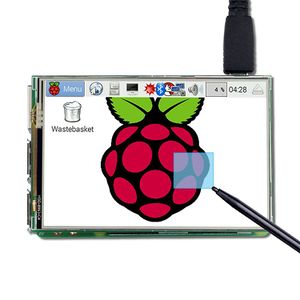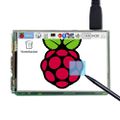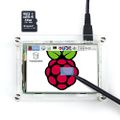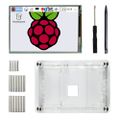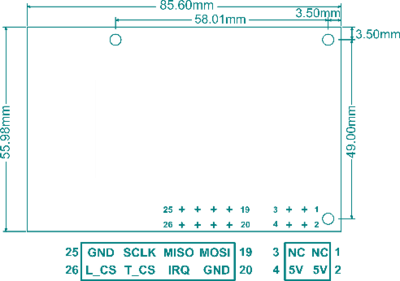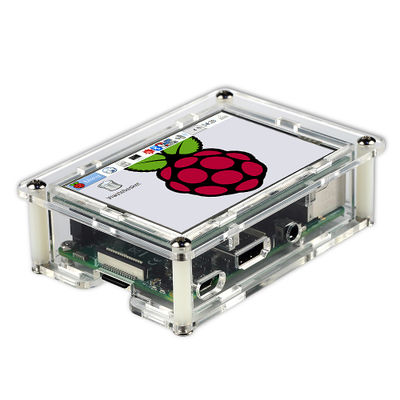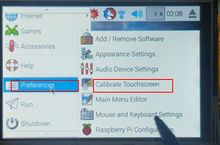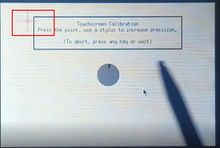Difference between revisions of "(SKU: U4703)UCTRONICS LCD35 RPI (SPI interface)"
(→Download and install driver) |
(→How to burn the UCTRONICS_LCD35_RPI.img?) |
||
| (20 intermediate revisions by the same user not shown) | |||
| Line 86: | Line 86: | ||
|} | |} | ||
| − | Figure 1 shows the display module pin out and dimension. | + | '''Figure 1''' shows the display module pin out and dimension. <br/> |
| − | Power on the Raspberry Pi board and make sure the internet is connected properly. | + | Connect the 3.5 inch LCD to the Raspberry Pi board like the '''Figure 2''' shows. <br/> |
| + | |||
| + | Power on the Raspberry Pi board and make sure the internet is connected properly.<br/> | ||
'''Note''': LCD module pin1 should be aligned to Raspberry Pi board Pin1, misalign might cause damage. | '''Note''': LCD module pin1 should be aligned to Raspberry Pi board Pin1, misalign might cause damage. | ||
| + | <br/> | ||
| + | <br/> | ||
| + | <br/> | ||
===Download and install driver=== | ===Download and install driver=== | ||
| − | The LCD driver has been already installed in the Micro SD card shipped only with the kit that includes a Micro SD card. The following steps are for installing the driver on a clean system. All the installation steps are also available on our GitHub site: | + | The LCD driver has been already installed in the Micro SD card shipped only with the kit that includes a Micro SD card. |
| + | <br/> | ||
| + | The following steps are for installing the driver on a clean system. All the installation steps are also available on our GitHub site: | ||
https://github.com/UCTRONICS/UCTRONICS_LCD35_RPI/ | https://github.com/UCTRONICS/UCTRONICS_LCD35_RPI/ | ||
*'''Step1: Expand the Micro SD card'''' | *'''Step1: Expand the Micro SD card'''' | ||
| + | |||
<code><span style="color: rgb(0,0,255)"> ''sudo raspi-config''</span></code> | <code><span style="color: rgb(0,0,255)"> ''sudo raspi-config''</span></code> | ||
| Line 102: | Line 110: | ||
then Select Advanced Operations -> <code><span style="color: rgb(0,0,255)"> ''Expand Filesystem''</span></code> and hit <code><span style="color: rgb(0,0,255)"> ''YES''</span></code> , then go to <code><span style="color: rgb(0,0,255)"> ''Finish''</span></code> and you need to run <code><span style="color: rgb(0,0,255)"> ''sudo reboot''</span></code> to reboot your Raspberry Pi. | then Select Advanced Operations -> <code><span style="color: rgb(0,0,255)"> ''Expand Filesystem''</span></code> and hit <code><span style="color: rgb(0,0,255)"> ''YES''</span></code> , then go to <code><span style="color: rgb(0,0,255)"> ''Finish''</span></code> and you need to run <code><span style="color: rgb(0,0,255)"> ''sudo reboot''</span></code> to reboot your Raspberry Pi. | ||
| + | <br/> | ||
| + | <br/> | ||
*'''Step2: Update your Raspberry Pi system''' | *'''Step2: Update your Raspberry Pi system''' | ||
<code><span style="color: rgb(0,0,255)"> ''sudo apt-get update''</span></code> | <code><span style="color: rgb(0,0,255)"> ''sudo apt-get update''</span></code> | ||
| + | <br/> | ||
| + | <br/> | ||
*'''Step3: Download the driver package''' | *'''Step3: Download the driver package''' | ||
<code><span style="color: rgb(0,0,255)"> ''sudo git clone https://github.com/UCTRONICS/UCTRONICS_LCD35_RPI.git''</span></code> | <code><span style="color: rgb(0,0,255)"> ''sudo git clone https://github.com/UCTRONICS/UCTRONICS_LCD35_RPI.git''</span></code> | ||
| + | <br/> | ||
| + | <br/> | ||
*'''Step4: Go to the UCTRONICS_LCD35_RPI''' | *'''Step4: Go to the UCTRONICS_LCD35_RPI''' | ||
<code><span style="color: rgb(0,0,255)"> ''cd UCTRONICS_LCD35_RPI''</span></code> | <code><span style="color: rgb(0,0,255)"> ''cd UCTRONICS_LCD35_RPI''</span></code> | ||
| + | <br/> | ||
| + | <br/> | ||
*'''Step5: Change the file permission''' | *'''Step5: Change the file permission''' | ||
| Line 124: | Line 140: | ||
<code><span style="color: rgb(0,0,255)"> ''sudo chmod 777 UCTRONICS_LCD_hdmi''</span></code> | <code><span style="color: rgb(0,0,255)"> ''sudo chmod 777 UCTRONICS_LCD_hdmi''</span></code> | ||
| + | <br/> | ||
| + | <br/> | ||
*'''Step6: Backup original system data''' | *'''Step6: Backup original system data''' | ||
<code><span style="color: rgb(0,0,255)"> ''sudo ./UCTRONICS_LCD_backup''</span></code> | <code><span style="color: rgb(0,0,255)"> ''sudo ./UCTRONICS_LCD_backup''</span></code> | ||
| − | *'''Step7: Install the LCD35 driver | + | <br/> |
| + | <br/> | ||
| + | *'''Step7: Install the LCD35 driver''' | ||
<code><span style="color: rgb(0,0,255)"> ''sudo ./UCTRONICS_LCD35_install''</span></code> | <code><span style="color: rgb(0,0,255)"> ''sudo ./UCTRONICS_LCD35_install''</span></code> | ||
| Line 140: | Line 160: | ||
<code><span style="color: rgb(0,0,255)"> ''sudo ./UCTRONICS_LCD_hdmi''</span></code> | <code><span style="color: rgb(0,0,255)"> ''sudo ./UCTRONICS_LCD_hdmi''</span></code> | ||
| + | <br/> | ||
If you don’t want to run those command to install the LCD driver, we also provide ready to use system image file “UCTRONICS_LCD35_RPI.img". Please click the following link to download the system image file: | If you don’t want to run those command to install the LCD driver, we also provide ready to use system image file “UCTRONICS_LCD35_RPI.img". Please click the following link to download the system image file: | ||
| Line 148: | Line 169: | ||
https://sourceforge.net/projects/win32diskimager/ | https://sourceforge.net/projects/win32diskimager/ | ||
| + | |||
| + | <br/> | ||
| + | <br/> | ||
| + | <br/> | ||
| + | <br/> | ||
| + | <br/> | ||
==Add more functions to the LCD== | ==Add more functions to the LCD== | ||
| Line 159: | Line 186: | ||
<code><span style="color: rgb(0,0,255)"> ''sudo dpkg -i -B xinput-calibrator_0.7.5-1_armhf.deb''</span></code> | <code><span style="color: rgb(0,0,255)"> ''sudo dpkg -i -B xinput-calibrator_0.7.5-1_armhf.deb''</span></code> | ||
| + | <br/> | ||
====Install virtual keyboard==== | ====Install virtual keyboard==== | ||
| − | + | <br/> | |
| + | '''Step 1: Execute the following commands to install the corresponding software''' | ||
<code><span style="color: rgb(0,0,255)"> ''sudo apt-get update''</span></code> | <code><span style="color: rgb(0,0,255)"> ''sudo apt-get update''</span></code> | ||
| Line 168: | Line 197: | ||
<code><span style="color: rgb(0,0,255)"> ''sudo nano /usr/bin/toggle-matchbox-keyboard.sh''</span></code> | <code><span style="color: rgb(0,0,255)"> ''sudo nano /usr/bin/toggle-matchbox-keyboard.sh''</span></code> | ||
| − | + | <br/> | |
| − | + | <br/> | |
| + | '''Step 2: Copy the following contents to toggle box - keyboard. Sh, save the exit''' | ||
#!/bin/bash | #!/bin/bash | ||
| Line 179: | Line 209: | ||
matchbox-keyboard -s 50 extended& | matchbox-keyboard -s 50 extended& | ||
fi | fi | ||
| − | + | <br/> | |
| − | + | <br/> | |
| + | '''Step 3: Execute the following command''' | ||
<code><span style="color: rgb(0,0,255)"> ''sudo chmod +x /usr/bin/toggle-matchbox-keyboard.sh''</span></code> | <code><span style="color: rgb(0,0,255)"> ''sudo chmod +x /usr/bin/toggle-matchbox-keyboard.sh''</span></code> | ||
| Line 187: | Line 218: | ||
<code><span style="color: rgb(0,0,255)"> ''sudo nano /usr/local/share/applications/toggle-matchbox-keyboard.desktop''</span></code> | <code><span style="color: rgb(0,0,255)"> ''sudo nano /usr/local/share/applications/toggle-matchbox-keyboard.desktop''</span></code> | ||
| − | + | <br/> | |
| − | + | <br/> | |
| + | '''Step 4: Copy the following contents to toggle - matchbox - keyboard. Desktop, save exit''' | ||
[Desktop Entry] | [Desktop Entry] | ||
| Line 198: | Line 230: | ||
Categories=Panel;Utility;MB | Categories=Panel;Utility;MB | ||
X-MB-INPUT-MECHANSIM=True | X-MB-INPUT-MECHANSIM=True | ||
| − | + | <br/> | |
| − | + | <br/> | |
| + | '''Step 5: To perform the following command, note that this step must use the "PI" user permission, and if the administrator privileges are used, the file will not be found''' | ||
<code><span style="color: rgb(0,0,255)"> ''nano ~/.config/lxpanel/LXDE-pi/panels/panel''</span></code> | <code><span style="color: rgb(0,0,255)"> ''nano ~/.config/lxpanel/LXDE-pi/panels/panel''</span></code> | ||
| − | + | <br/> | |
| − | + | <br/> | |
| + | '''Step 6: Find similar commands (different versions of ICONS may differ)''' | ||
Plugin { | Plugin { | ||
| Line 215: | Line 249: | ||
} | } | ||
} | } | ||
| − | + | <br/> | |
| − | + | <br/> | |
| + | '''Step 7: Add the following code to add a Button item''' | ||
Button { | Button { | ||
id=/usr/local/share/applications/toggle-matchbox-keyboard.desktop | id=/usr/local/share/applications/toggle-matchbox-keyboard.desktop | ||
} | } | ||
| − | + | <br/> | |
| − | + | <br/> | |
| + | '''Step 8: To restart the system with the following command, you can see a virtual keyboard icon in the top left corner''' | ||
<code><span style="color: rgb(0,0,255)"> ''sudo reboot''</span></code> | <code><span style="color: rgb(0,0,255)"> ''sudo reboot''</span></code> | ||
| Line 228: | Line 264: | ||
=== Contact us=== | === Contact us=== | ||
If need any further support, please feel free to contact us. | If need any further support, please feel free to contact us. | ||
| − | {| border="1" cellspacing="5" cellpadding="5 | + | {| border="1" cellspacing="5" cellpadding="5" |
!Website: http://www.uctronics.com | !Website: http://www.uctronics.com | ||
|- | |- | ||
| Line 235: | Line 271: | ||
!Tel: +86 025 84271192 | !Tel: +86 025 84271192 | ||
|} | |} | ||
| + | |||
| + | <br/> | ||
| + | <br/> | ||
==Trouble Shooting== | ==Trouble Shooting== | ||
| + | |||
===How to add new ICON to desktop ?=== | ===How to add new ICON to desktop ?=== | ||
If it's just a folder, add it directly to the desktop | If it's just a folder, add it directly to the desktop | ||
| Line 245: | Line 285: | ||
*Step2: choose a icon you want to link | *Step2: choose a icon you want to link | ||
*Step3: choose edit -> create link... ->Desktop ->OK | *Step3: choose edit -> create link... ->Desktop ->OK | ||
| + | <br/> | ||
| + | <br/> | ||
| + | |||
===How to rotate the screen to 180 degree ?=== | ===How to rotate the screen to 180 degree ?=== | ||
| Line 256: | Line 299: | ||
0 degree 180 degree | 0 degree 180 degree | ||
| + | <br/> | ||
| + | <br/> | ||
===Some zones working much better than others, the near edge zones seem the worst.=== | ===Some zones working much better than others, the near edge zones seem the worst.=== | ||
*You should recalibrate the touchscreen. | *You should recalibrate the touchscreen. | ||
| Line 271: | Line 316: | ||
[[Image:calibration1.jpeg|220px|]] [[Image:calibration2.jpeg|220px|]] | [[Image:calibration1.jpeg|220px|]] [[Image:calibration2.jpeg|220px|]] | ||
| + | <br/> | ||
| + | <br/> | ||
=== How to burn the UCTRONICS_LCD35_RPI.img?=== | === How to burn the UCTRONICS_LCD35_RPI.img?=== | ||
| − | + | *'''Step1: Download the burn tools from''' | |
https://github.com/UCTRONICS/Win32DiskImager.git | https://github.com/UCTRONICS/Win32DiskImager.git | ||
| − | + | *'''Step2: Download the UCTRONICS_LCD35_RPI.img file from''' | |
http://uctronics.oss-us-west-1.aliyuncs.com/LCD35/image/UCTRONICS_LCD35_RPI.img | http://uctronics.oss-us-west-1.aliyuncs.com/LCD35/image/UCTRONICS_LCD35_RPI.img | ||
| − | + | *'''Step3: Open the SDFormatter to format your SD card''' | |
| − | + | *'''Step4: Open the Win32DiskImager to write the UCTRONICS_LCD35_RPI.img to your SD card.''' | |
For more details please refer to our video demo from | For more details please refer to our video demo from | ||
https://www.youtube.com/watch?v=cCw91wH6mnc | https://www.youtube.com/watch?v=cCw91wH6mnc | ||
| + | <br/> | ||
| + | <br/> | ||
| + | |||
=== Why the HDMI display stop at rainbow ?=== | === Why the HDMI display stop at rainbow ?=== | ||
After loading our LCD35 SPI driver, the system just supports our LCD35 screen which means you can't use the HDMI screen. | After loading our LCD35 SPI driver, the system just supports our LCD35 screen which means you can't use the HDMI screen. | ||
| + | <br/> | ||
| + | <br/> | ||
=== Why the screen is always white and doesn't display anything?=== | === Why the screen is always white and doesn't display anything?=== | ||
Please ensure the hardware connection is normal. If the hardware connection is incorrect, the LCD will not work fine. | Please ensure the hardware connection is normal. If the hardware connection is incorrect, the LCD will not work fine. | ||
Latest revision as of 05:36, 10 May 2018
UCTRONICS 3.5 inch TFT LCD display module is designed for Raspberry Pi zero/Pi 2 /Pi 3 Model B / B+ /Pi 3 B+, and can also be used on other hardware platforms with an SPI interface. The 3.5' inch screen is in the same size as the standard Raspberry Pi model B/B+, and well mates with the Raspberry Pi boards. With its touchscreen, it is suitable for portable devices and projects. It is also a replacement for a heavy and bulky HDMI monitor, keyboard and mouse.
The highlight of this display module: it supports plug-and-play without rebooting the Pi, and SPI speed runs as fast as 32MHz.
Contents
- 1 UCTRONICS 3.5 Inches 480 x 320 TFT LCD Touch Screen Display
- 2 Add more functions to the LCD
- 3 Trouble Shooting
- 3.1 How to add new ICON to desktop ?
- 3.2 How to rotate the screen to 180 degree ?
- 3.3 Some zones working much better than others, the near edge zones seem the worst.
- 3.4 How to burn the UCTRONICS_LCD35_RPI.img?
- 3.5 Why the HDMI display stop at rainbow ?
- 3.6 Why the screen is always white and doesn't display anything?
UCTRONICS 3.5 Inches 480 x 320 TFT LCD Touch Screen Display
Model: U4703
Variations: U470301,U470302,U470303
Specification
| Support Kernel from 4.1 to 4.14 | Support plug and play |
| Resolution: 480 x 320 pixels | Support touch screen |
| Interface: SPI | Support game and video |
| SPI speed: 32MHz | Automatic driver installation script |
| Dimension: 55.98 x 85.60 mm | Well mate with Pi Zero, Pi B+, Pi2, Pi3 and Pi3 B+ |
Hardware installation
| Figure1 |
| Figure2 |
Figure 1 shows the display module pin out and dimension.
Connect the 3.5 inch LCD to the Raspberry Pi board like the Figure 2 shows.
Power on the Raspberry Pi board and make sure the internet is connected properly.
Note: LCD module pin1 should be aligned to Raspberry Pi board Pin1, misalign might cause damage.
Download and install driver
The LCD driver has been already installed in the Micro SD card shipped only with the kit that includes a Micro SD card.
The following steps are for installing the driver on a clean system. All the installation steps are also available on our GitHub site:
https://github.com/UCTRONICS/UCTRONICS_LCD35_RPI/
- Step1: Expand the Micro SD card'
sudo raspi-config
then Select Advanced Operations -> Expand Filesystem and hit YES , then go to Finish and you need to run sudo reboot to reboot your Raspberry Pi.
- Step2: Update your Raspberry Pi system
sudo apt-get update
- Step3: Download the driver package
sudo git clone https://github.com/UCTRONICS/UCTRONICS_LCD35_RPI.git
- Step4: Go to the UCTRONICS_LCD35_RPI
cd UCTRONICS_LCD35_RPI
- Step5: Change the file permission
sudo chmod 777 UCTRONICS_LCD_backup
sudo chmod 777 UCTRONICS_LCD35_install
sudo chmod 777 UCTRONICS_LCD_restore
sudo chmod 777 UCTRONICS_LCD_hdmi
- Step6: Backup original system data
sudo ./UCTRONICS_LCD_backup
- Step7: Install the LCD35 driver
sudo ./UCTRONICS_LCD35_install
Wait for a while the system will be installed and restarted automatically. If you want to reuse the original system, you can use the below command
sudo ./UCTRONICS_LCD_restore
If you want to display on HDMI instead of LCD, just use the below command
sudo ./UCTRONICS_LCD_hdmi
If you don’t want to run those command to install the LCD driver, we also provide ready to use system image file “UCTRONICS_LCD35_RPI.img". Please click the following link to download the system image file:
http://uctronics.oss-us-west-1.aliyuncs.com/LCD35/image/UCTRONICS_LCD35_RPI.img
Check the following link to install the win32diskimager tool on your computer. Then write the image file into the Micro SD card.
https://sourceforge.net/projects/win32diskimager/
Add more functions to the LCD
Install calibration software for calibration
cd UCTRONICS_LCD35_RPI
sudo unzip Xinput-calibrator_0.7.5-1_armhf.zip
cd xinput-calibrator_0.7.5-1_armhf/
sudo dpkg -i -B xinput-calibrator_0.7.5-1_armhf.deb
Install virtual keyboard
Step 1: Execute the following commands to install the corresponding software
sudo apt-get update
sudo apt-get install matchbox-keyboard
sudo nano /usr/bin/toggle-matchbox-keyboard.sh
Step 2: Copy the following contents to toggle box - keyboard. Sh, save the exit
#!/bin/bash #This script toggle the virtual keyboard PID=pidof matchbox-keyboard if [ ! -e $PID ]; then killall matchbox-keyboard else matchbox-keyboard -s 50 extended& fi
Step 3: Execute the following command
sudo chmod +x /usr/bin/toggle-matchbox-keyboard.sh
sudo mkdir /usr/local/share/applications
sudo nano /usr/local/share/applications/toggle-matchbox-keyboard.desktop
Step 4: Copy the following contents to toggle - matchbox - keyboard. Desktop, save exit
[Desktop Entry] Name=Toggle Matchbox Keyboard Comment=Toggle Matchbox Keyboard` Exec=toggle-matchbox-keyboard.sh Type=Application Icon=matchbox-keyboard.png Categories=Panel;Utility;MB X-MB-INPUT-MECHANSIM=True
Step 5: To perform the following command, note that this step must use the "PI" user permission, and if the administrator privileges are used, the file will not be found
nano ~/.config/lxpanel/LXDE-pi/panels/panel
Step 6: Find similar commands (different versions of ICONS may differ)
Plugin {
type = launchbar
Config {
Button {
id=lxde-screenlock.desktop
}
Button {
id=lxde-logout.desktop
}
}
Step 7: Add the following code to add a Button item
Button {
id=/usr/local/share/applications/toggle-matchbox-keyboard.desktop
}
Step 8: To restart the system with the following command, you can see a virtual keyboard icon in the top left corner
sudo reboot
Contact us
If need any further support, please feel free to contact us.
| Website: http://www.uctronics.com |
|---|
| Email: [email protected] |
| Tel: +86 025 84271192 |
Trouble Shooting
How to add new ICON to desktop ?
If it's just a folder, add it directly to the desktop
If it is an executable, follow this steps:
- Step1: choose the Directory Tree -> / -> usr -> share ->applications folder
- Step2: choose a icon you want to link
- Step3: choose edit -> create link... ->Desktop ->OK
How to rotate the screen to 180 degree ?
cd UCTRONICS_LCD35_RPI
sudo chmod 777 UCTRONICS_LCD35_rotation_180_install
sudo ./UCTRONICS_LCD35_rotation_180_install
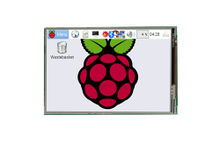
0 degree 180 degree
Some zones working much better than others, the near edge zones seem the worst.
- You should recalibrate the touchscreen.
- Downloading our UCTRONICS_LCD35_HDMI_RPI package from
https://github.com/UCTRONICS/UCTRONICS_LCD35_RPI.git
- Install calibration software for calibration
cd UCTRONICS_LCD35_RPI
sudo unzip Xinput-calibrator_0.7.5-1_armhf.zip
cd xinput-calibrator_0.7.5-1_armhf/
sudo dpkg -i -B xinput-calibrator_0.7.5-1_armhf.deb
How to burn the UCTRONICS_LCD35_RPI.img?
- Step1: Download the burn tools from
https://github.com/UCTRONICS/Win32DiskImager.git
- Step2: Download the UCTRONICS_LCD35_RPI.img file from
http://uctronics.oss-us-west-1.aliyuncs.com/LCD35/image/UCTRONICS_LCD35_RPI.img
- Step3: Open the SDFormatter to format your SD card
- Step4: Open the Win32DiskImager to write the UCTRONICS_LCD35_RPI.img to your SD card.
For more details please refer to our video demo from
https://www.youtube.com/watch?v=cCw91wH6mnc
Why the HDMI display stop at rainbow ?
After loading our LCD35 SPI driver, the system just supports our LCD35 screen which means you can't use the HDMI screen.
Why the screen is always white and doesn't display anything?
Please ensure the hardware connection is normal. If the hardware connection is incorrect, the LCD will not work fine. Please ensure you have installed the LCD35 driver following the
https://github.com/UCTRONICS/UCTRONICS_LCD35_RPI/blob/master/README.md
if you don't install it, the LCD will not work fine.
